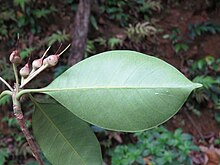Gutta-percha trees
| Gutta-percha trees | ||||||||||||
|---|---|---|---|---|---|---|---|---|---|---|---|---|

Gutta-percha tree ( Palaquium gutta ), illustration |
||||||||||||
| Systematics | ||||||||||||
|
||||||||||||
| Scientific name | ||||||||||||
| Palaquium | ||||||||||||
| Blanco |

The gutta-percha trees ( Palaquium ) are a species-rich plant genus from the family of the sapotaceae (Sapotaceae). They are common in the tropics of Southeast Asia and northern Australia. The best-known species is the gutta-percha tree ( Palaquium gutta ), whose dried milky sap originally mainly supplied the important raw material gutta-percha , but this is also obtained from other types of gutta-percha trees and various sapoteic plants.
description
Palaquium species grow as evergreen trees and, depending on the species, reach heights of growth of 5 to 30 meters and sometimes trunk circumferences of up to 1 meter. They contain milk juice (latex). The leaves are arranged alternately and / or in two rows or in several together standing leaves are simple, leathery and 8 to 25 cm long. On the top they are glossy green, on the underside they are often yellow or gray-green. The small to very large stipules fall off early.
The flowers stand alone or in groups along the branches, or in short terminal inflorescences. At the base of the inflorescence shafts there are conspicuous bracts. There are two circles with a total of usually six (four to seven) sepals . There are four to six petals available. The mostly 12 to 18 (8 to 36) fertile stamens standing in two or three circles are inserted in the corolla tube. The stamens are long. In contrast to other genera from the family, there are no staminodes . Most six (five to eleven) carpels are a hairy upper permanent ovary grown. There is only one anatropic, hanging ovule per carpel .
The 3 to 7 cm long, elongated to ellipsoidal berry contains one to four seeds. A scar covers half of the surface of the seed.
distribution
The palaquium species are common in the tropics of Southeast Asia and northern Australia . The deposits extend north to Taiwan , south to the Malay Peninsula and in an easterly direction to the Solomon Islands .
Systematics
The genus Palaquium was established in 1837 by Francisco Manuel Blanco in Flora de Filipinas , p. 403. In 1903 the lectotype Palaquium lanceolatum Blanco was established. Synonyms for Palaquium Blanco are: Croixia Pierre , Dichopsis Thwaites , Galactoxylon Pierre , Treubella Pierre . The genus Palaquium belongs to the tribe Sapoteae in the subfamily Sapotoideae in the family Sapotaceae .

There are around 120 types of palaquium (here is a selection):
- Palaquium amboinense Burck : The distribution area ranges from Java to the Solomon Islands .
- Palaquium burckii H.J.Lam : The range extends from Malaysia to Sumatra.
- Palaquium calophyllum (Teijsm. & Binn.) Pierre : Syn .: Isonandra calophylla Teijsm. & Binn. : The home is Borneo and the Philippines.
- Palaquium ellipticum (Dalzell) Baill. : It occurs in western and south-western India.
- Palaquium formosanum Hay. : The home is Taiwan and the Philippines.
- Gutta Percha ( Palaquium gutta .. (Hook) Baill ; Syn .: Isonandra gutta . Hook , Isonandra gutta var. Oblongifolia de Briese , Palaquium oblongifolium (Burck) Burck ): The home is Malaysia, Borneo, Sumatra and Java.
- Palaquium hexandrum (handle.) Baill. : The homeland is Malaysia, Borneo and Sumatra.
- Palaquium leiocarpum Boerl. : The homeland is Malesia.
- Palaquium luzoniense (Fern.-Vill.) S.Vidal : Syn .: Dichopsis luzoniensis Fern.-Vill. : The distribution area extends from the Philippines to Sulawesi.
- Palaquium maingayi (CBClarke) King & Gamble : The home is Thailand and Malaysia.
- Palaquium merrillii Dubard : The home is the Philippines.
- Palaquium obovatum (Griff.) Engl .: The range extends from India to Malesia.
- Palaquium philippense (Perr.) CBRob. : Syn .: Chrysophyllum philippense Perr. : The home is the Philippines.
- Palaquium polyandrum C.B.Rob. : The home is the Philippines.
- Palaquium ridleyi King & Gamble : The distribution area extends from Vietnam to New Guinea.
- Palaquium rostratum (Miq.) Burck : The range extends from Thailand to Malesia.
- Palaquium stellatum King & Gamble : The home is Boneo, Malaysia and Sumatra.
use
The gutta-percha , the dried milky sap of the gutta-percha tree ( Palaquium gutta ), is an important raw material that was previously used for cable insulation and is still used today, among other things, as a filling material in dentistry .
The berries are edible in several species.
Many species of the genus also provide valuable wood.
swell
- Shugang Li & TD Pennington: Sapotaceae in the Flora of China , Volume 15, p. 206: Palaquium - Online. (Section description)
Individual evidence
- ^ Palaquium at Tropicos.org. Missouri Botanical Garden, St. Louis
- ^ A b Palaquium in the Germplasm Resources Information Network (GRIN), USDA , ARS , National Genetic Resources Program. National Germplasm Resources Laboratory, Beltsville, Maryland.
- ↑ a b c d e f g h i j k l m n o p q r Rafaël Govaerts (Ed.): Palaquium. In: World Checklist of Selected Plant Families (WCSP) - The Board of Trustees of the Royal Botanic Gardens, Kew . Retrieved September 28, 2017.
